Florida is home to an abundance of diverse bees. These buzzing creatures play a crucial role in pollinating crops and wildflowers while also producing honey and wax. However, they can be bothersome when they swarm. Read on to learn about the various bee species in Florida and their swarming habits!
1. Western Honeybees (Apis Mellifera)
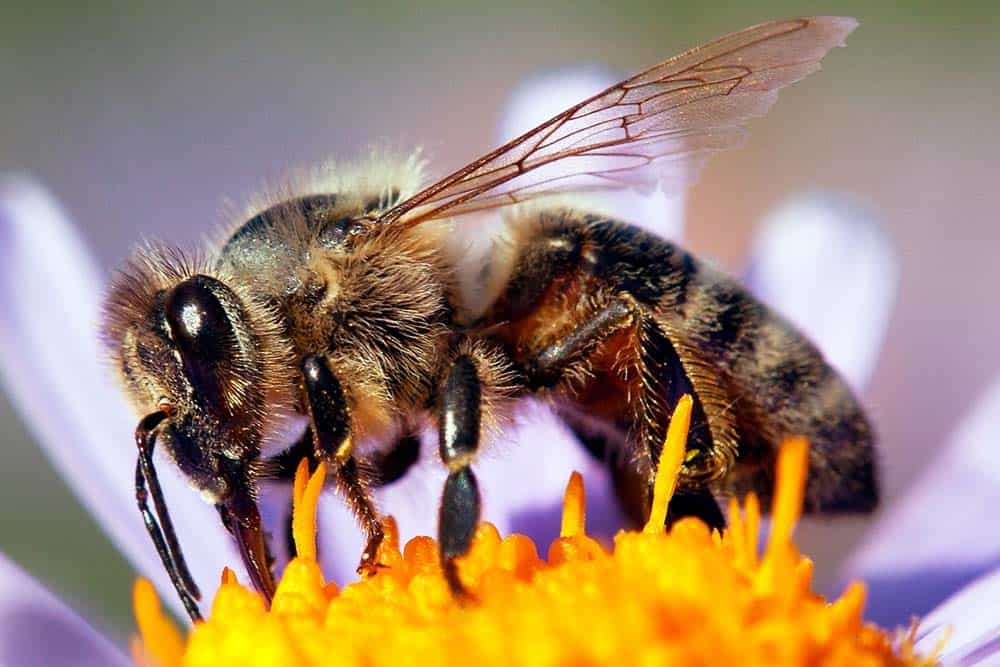
The
Western honeybee
can sting just like other bees. But, it’s only the female
worker bees
that do the stinging.
©Daniel Prudek/Shutterstock.com
The western honeybee, or the European honeybee, is the most widespread of all honeybee species around the world. Thanks to domestication, it has earned the nickname “domestic honeybee.”
This species lives in colonies with a single queen, numerous workers, and a few drones. They have an intricate communication system through pheromones and a unique dance language that indicates the direction and distance of food sources. One captivating habit of the western honeybee is their swarming, where they fly in a cloud-like shape till they discover an ideal spot to settle.
The Western honeybee can sting just like other bees. But, it’s only the female worker bees that do the stinging. They usually only do it if they feel scared or aggravated. Even though getting stung can hurt, it usually won’t cause any harm unless you have an allergy.
2. Bumblebees (Bombus)
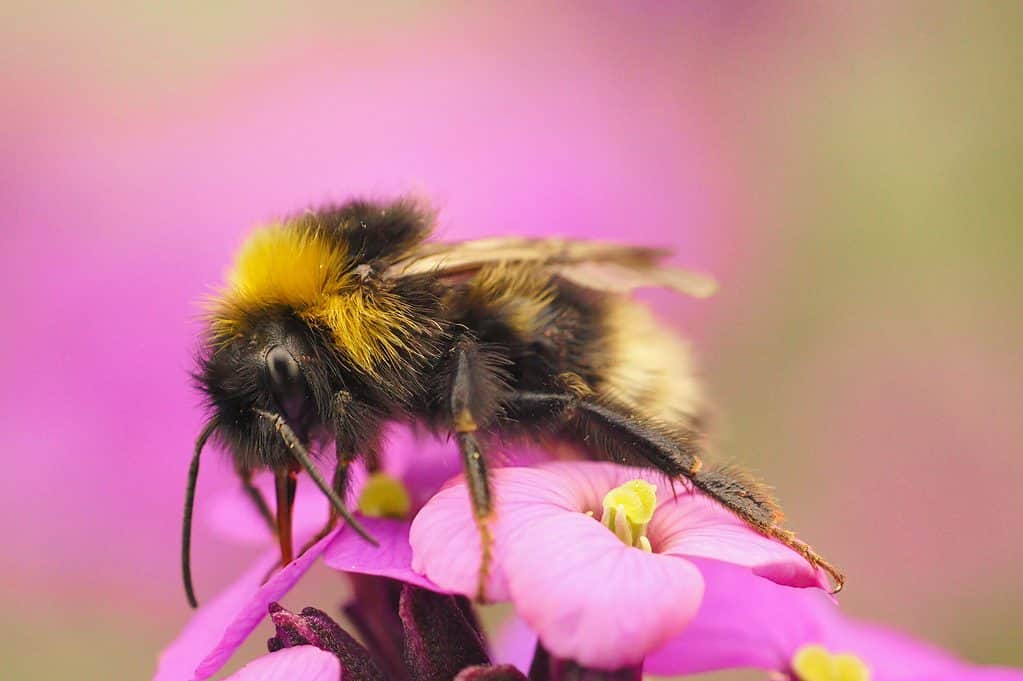
The
Bumblebee
family consists of over 250 distinct species.
©HWall/Shutterstock.com
Bumblebees are crucial pollinators for fruits and vegetables, despite not making honey. They consume nectar from flowering plants and gather pollen to nourish their offspring. Their hind legs contain small pouches called corbiculae, where they store the pollen after visiting several flowers.
Bumblebees form colonies of up to 150 worker bees with a single queen. The Bumblebee family consists of over 250 distinct species. Unlike most other bee families, Bumblebees can pollinate plants inside greenhouses. Due to this unique skill, they’ve been deliberately bred to pollinate tomato plants in food production.
Bumblebees swarm for two reasons: to find new nests or mates. In spring, the queens come out of hibernation and hunt for good spots to build their colony, like abandoned mouse holes or grass clumps. Sometimes they circle an area a few times before settling on a location. Meanwhile, workers also swarm as they search for nectar and pollen.
3. Large Carpenter Bees (Xylocopa)
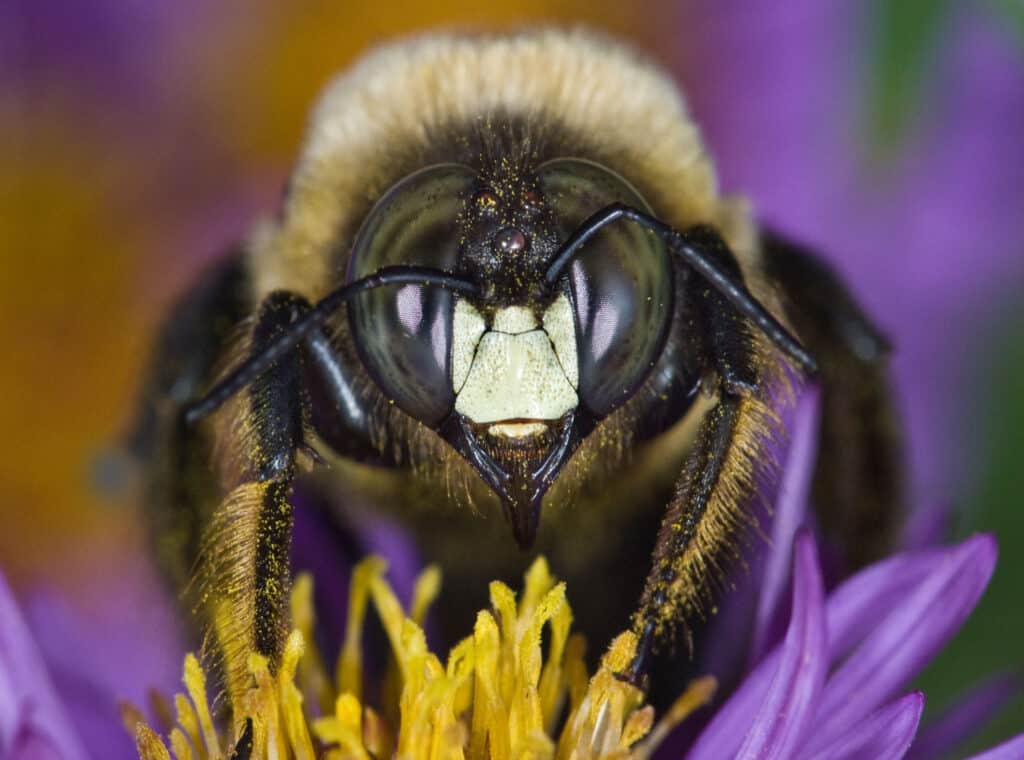
Carpenter bees are skilled carpenters; they build nests by drilling holes into wood.
©Gerry Bishop/Shutterstock.com
Large carpenter bees look like bumblebees but with shiny abdomens, not furry ones. They’re solitary insects that don’t live in colonies or make honey. They also pollinate many types of flowers
Carpenter bees are skilled carpenters; they build nests by drilling holes into wood. Unlike honeybees, they don’t swarm. Their preferred wood types are pine, cedar, and redwood. These bees usually target wooden structures like decks, fences, siding, and eaves. They don’t eat the wood but use it to construct tunnels and chambers to lay eggs and store pollen.
Carpenter bees won’t sting if they’re not provoked, but they can cause damage to wood by drilling holes and leaving stains. If left unaddressed, this can attract woodpeckers to peck the wood to get to the larvae.
4. Small Carpenter Bees (Ceratina)
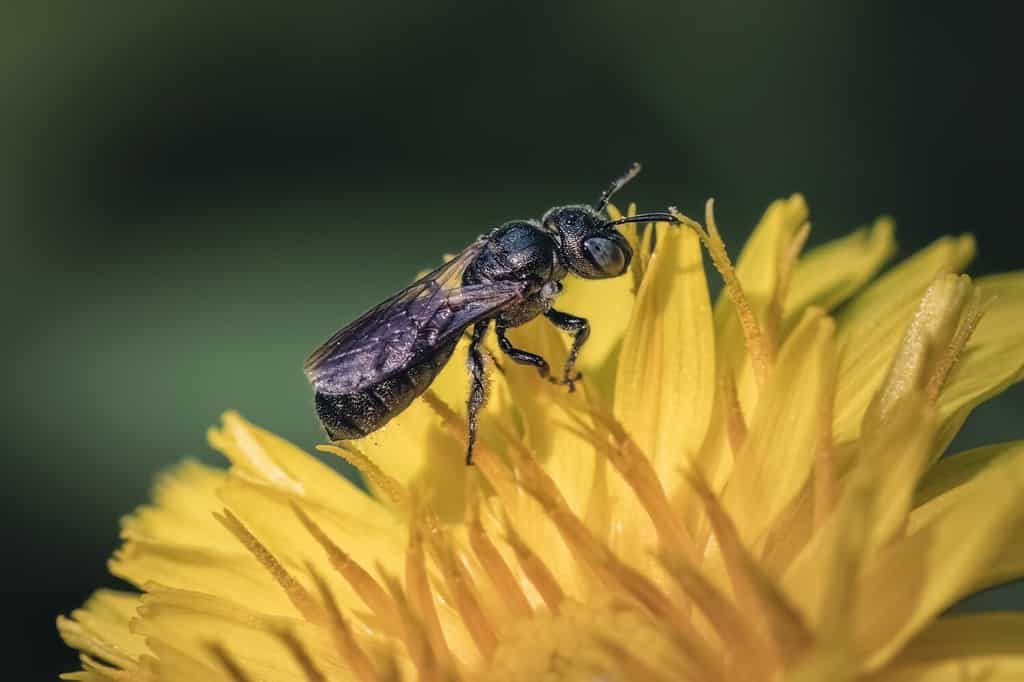
Some small carpenter bees can reproduce through
parthenogenesis
, meaning they don’t need male bees.
©Victoria Virgona/Shutterstock.com
Small carpenter bees are even more fascinating than their larger counterparts. Large carpenter bees behave solitarily, but small carpenter bees sometimes live together with other female bees. Some small carpenter bees can reproduce through parthenogenesis, meaning they don’t need male bees.
Despite their reputation as nuisances, carpenter bees are vital pollinators for many plants, including wildflowers, garden plants, and fruit trees. These plants rely heavily on these bees for survival and reproduction.
5. Sweat Bees (Halictidae)
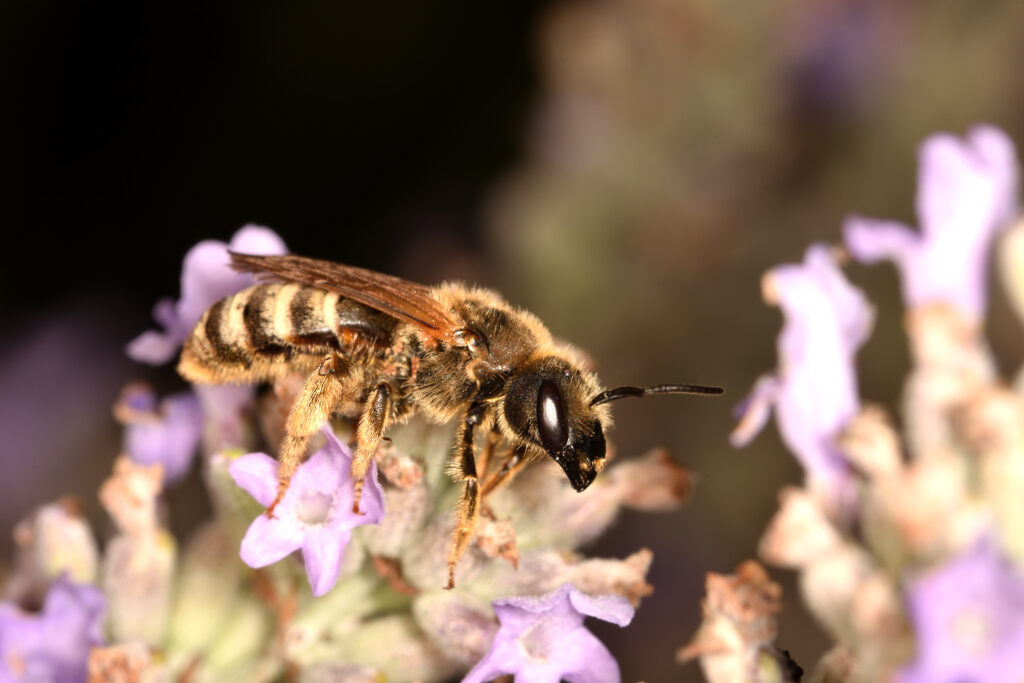
Sweat bees are among the smallest bees in the world, measuring less than half an inch in length.
©Davide Bonora/Shutterstock.com
Ever had a little bee land on your skin and suck your sweat? That’s probably a sweat bee from the Halictidae family. In the US, there are more than 500 types of these bees. They pollinate flowers and like salt and moisture, which they get from human sweat.
Sweat bees are among the smallest bees in the world, measuring less than half an inch in length. With their uniquely designed mouthparts, they can chew and suck, allowing them to ingest pollen, nectar, and sweat.
Depending on their species, they can live in solitude or as part of a community. Solitary sweat bees construct their nests deep in the soil or wood. Conversely, social sweat bees live in colonies with a queen, sharing a nest and labor duties amongst workers.
6. Squash Bees (Peponapis)
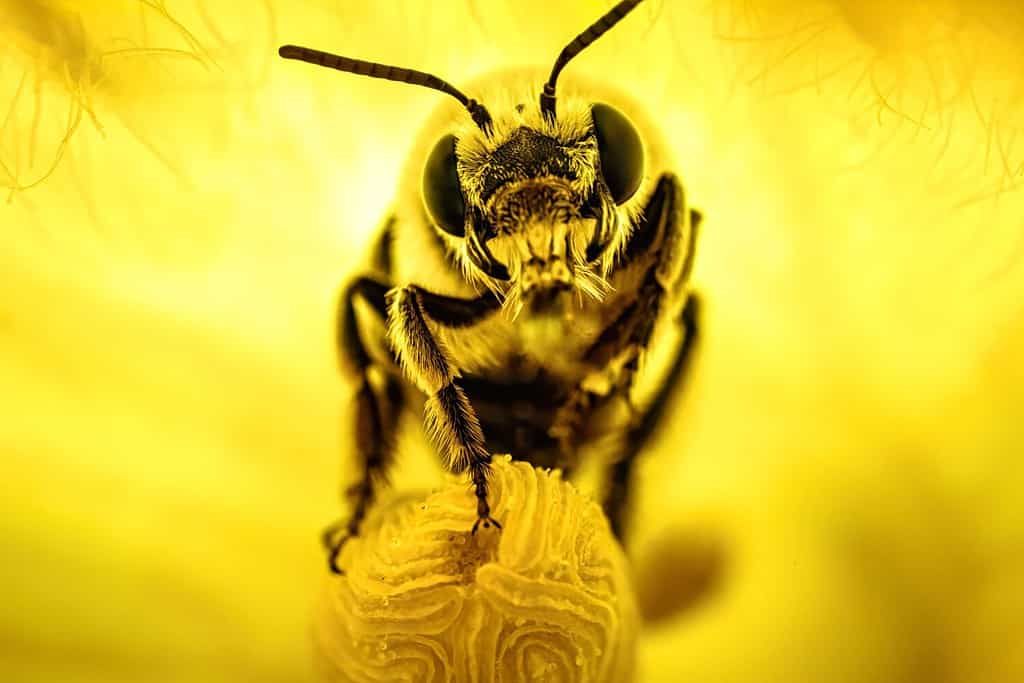
Squash bees have a matinal activity cycle, meaning they fly before sunrise when the cucurbit flowers are open.
©Joseph Burdick/Shutterstock.com
They have a close relationship with cucurbit plants, such as squash, pumpkins, and gourds. They’re the only bees that specialize in collecting pollen from these plants and are very efficient pollinators of them. Squash bees are solitary and dig their nests in the ground, often near the plants they visit.
Squash bees are larger and bulkier than honeybees, with longer antennae and rounder faces. They have unbranched hairs on their legs to carry host plants’ large, coarse pollen. Squash bees have a matinal activity cycle, meaning they fly before sunrise when the cucurbit flowers are open. They can also fly in near-darkness, thanks to their enlarged ocelli – simple eyes on the top of their head.
Squash Bees have interesting behaviors, such as sleeping inside the withered flowers after mating or foraging. They may switch between different flowers or nest sites without a clear pattern or reason. Squash bees are native to the Americas and have co-evolved with cucurbit plants for millions of years.
7. Long-Horned Bees (Eucerini)
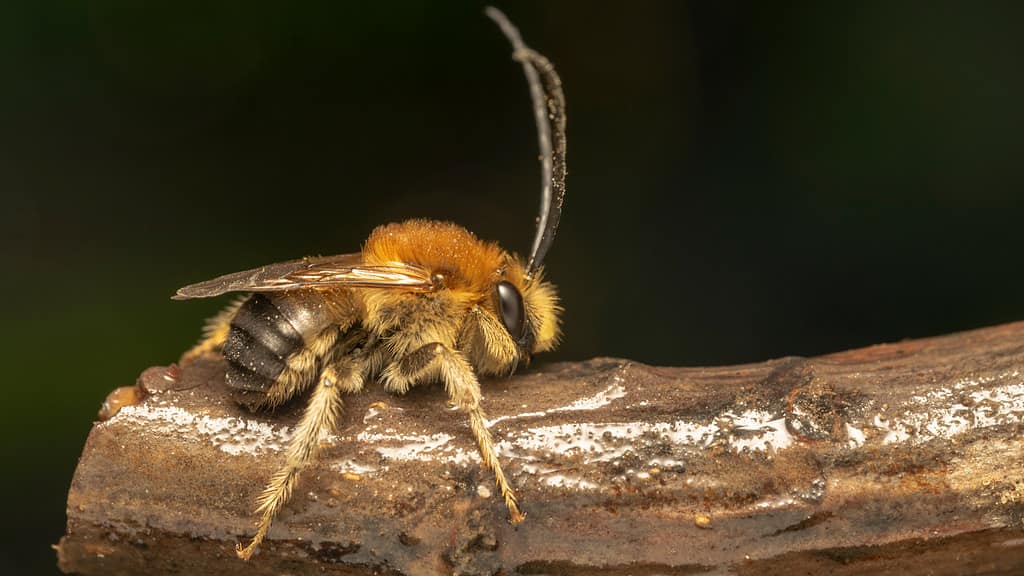
They’re called long-horned because of their unusually long antennae, especially in males, which can be twice as long as their bodies.
©tasnenad/Shutterstock.com
Long-Horned bees (Eucerini) are a group of insects that belong to the family Apidae, which includes honey bees, bumble bees, and carpenter bees. They’re called long-horned because of their unusually long antennae, especially in males, which can be twice as long as their bodies. These antennae are used to detect female pheromones and to locate flowers. Long-Horned bees are found all over the world, with over 32 genera.
These bees prefer solitude over colonies or social structures like honey bees or bumble bees. Females build their own nests, typically underground or in crevices. They gather pollen and nectar from diverse flowers and create balls to store in their nest cells.
Long-Horned bees have interesting behaviors that make them stand out from other bees. For example, many species form large aggregations of nests, sometimes with thousands of individuals nesting close together. This may provide protection from predators, parasites or facilitate mating opportunities.
8. Polyester Bees (Colletidae)
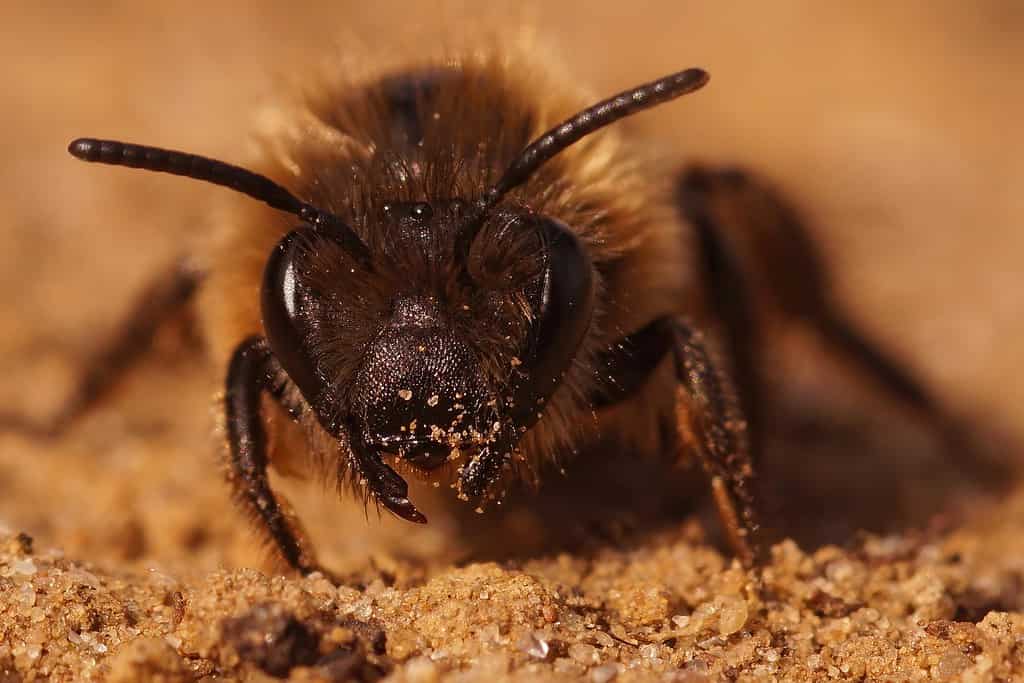
They are usually black with pale hairs on their thorax and abdomen.
©HWall/Shutterstock.com
Polyester bees are also known as plasterer bees or cellophane bees because they produce a special secretion from their mouthparts to line their nest cells. This secretion hardens into a waterproof protective layer resembling cellophane or polyester. Polyester bees are usually black with pale hairs on their thorax and abdomen.
These solitary bees have a short tongue and a bilobed glossa, which are primitive features among bees. They also have bare eyes, unlike honey bees, which have hairy eyes. Polyester bees collect pollen and nectar from various flowers, especially those in the aster family, and store them in their nest cells as food for their larvae.
Some polyester bees are active at dawn or dusk and have enlarged ocelli to see better in low-light conditions. These bees are important pollinators of many plants, crops and aren’t aggressive or dangerous to humans. Some species can also survive extreme temperatures by entering a state of torpor or hibernation.
9. Digger Bees (Anthophorini)

Digger bees are generally gigantic, measuring up to 3 cm in length. They have very hairy bodies and protruding faces.
©Michael Siluk/Shutterstock.com
Their name comes from their behavior of excavating holes in the ground to build their homes. Digger bees are solitary, meaning that each female constructs and provisions her own nest without the help of other bees. However, some species may nest in large aggregations, creating a buzzing spectacle of activity.
Digger bees are generally gigantic, measuring up to 3 cm in length. They have very hairy bodies and protruding faces. The tips of their wings are covered with tiny bumps called papillae. Their abdomens are often banded with different colors, such as metallic blue. Male digger bees often feature a unique white or yellow facial marking.
Digger bees are fast-flying and agile, they can hover and dart from flower to flower. However, these bees face a grave threat because they resemble wasps, leading people to kill or relocate them upon sight. Despite this, digger bees are peaceful creatures who will only sting if provoked.
10. Masked Bees (Hylaeus)

These tiny,
black
wasp-like creatures lack a scopa and transport pollen in their crop, regurgitating it into the larval cell.
©2051664692/Shutterstock.com
Masked bees, also called yellow-faced bees, have bold white or yellow facial markings resembling masks. These tiny, black wasp-like creatures lack a scopa and transport pollen in their crop, regurgitating it into the larval cell. They construct nests in natural cavities such as twigs, reeds, and branches, lining them with a cellophane-like secretion from their salivary glands. Certain species emit a potent, lemon-like odor.
Masked bees aren’t known to swarm or form large aggregations like other bees. However, they may nest near each other if suitable nesting sites are available. They’re solitary bees that don’t cooperate or share resources with other individuals of their species. They’re also generally non-aggressive and unlikely to sting unless provoked.
11. Mason bees (Osmia)
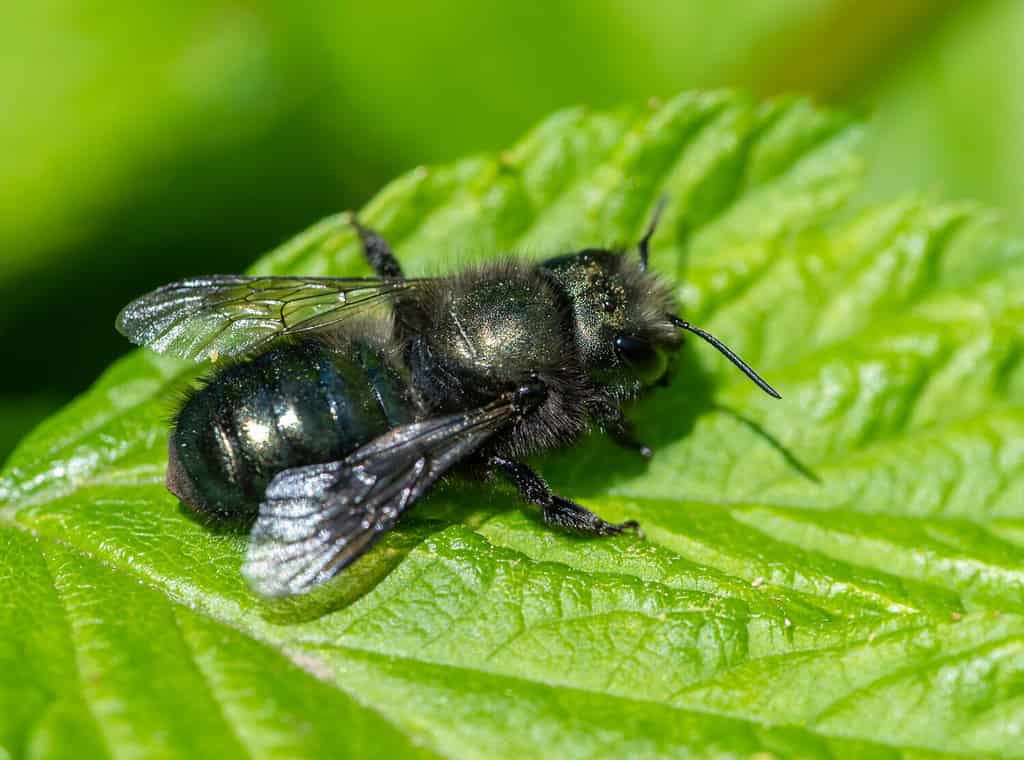
A Mason Bee (Osmia lignaria), resting on a Salmonberry leaf.Mason bees are essential pollinators of many plants, especially fruit trees and berries.
©Jennifer Bosvert/Shutterstock.com
Mason bees are a genus of solitary bees in the family Megachilidae, with over 300 species distributed across the Northern Hemisphere. They’re named for their habit of using mud or other materials to construct their nests in small cavities, such as cracks in stones, hollow stems, snail shells, or wood-boring insect holes.
Mason bees are essential pollinators of many plants, especially fruit trees and berries. They carry pollen on their abdomen hairs rather than in pollen baskets on their legs like honey bees or bumblebees. Each female can make up to seven cells in her lifetime. Surprisingly, these bees aren’t aggressive and unlikely to sting humans, making them a popular choice for backyard gardeners and beekeepers.
Although mason bees are solitary and don’t form colonies, they can sometimes exhibit swarm-like behavior when attracted to the same nesting site or source of mud. This can create a buzzing spectacle of hundreds or thousands of bees flying around a patch of soil or a wall. However, this isn’t a sign of aggression or danger but rather an indication of their nesting preference and social attraction.
12. Cuckoo Bees (Nomadinae)

Cuckoo bees don’t swarm. They’re solitary and don’t form colonies or hives.
©lego 19861111/Shutterstock.com
These are a subfamily of bees that parasitize the nests of other bees. They’re also known as kleptoparasites because they steal the food and resources of their hosts. Cuckoo bees have no pollen-collecting structures and often resemble wasps in appearance. They lay their eggs in the cells of their host bees, and their larvae kill and eat the host larvae and their provisions.
Cuckoo bees don’t swarm. They’re solitary and don’t form colonies or hives. They rely on finding and invading the nests of their host bees, which can be in various locations such as hollow stems, wood, or soil.
Cuckoo bees exhibit such a wide range of colors that identifying them requires careful scrutiny. Stripes of black and white adorn some, while others feature black bodies accentuated by vibrant red bands.
13. Leaf Cutter Bees (Megachilidae)
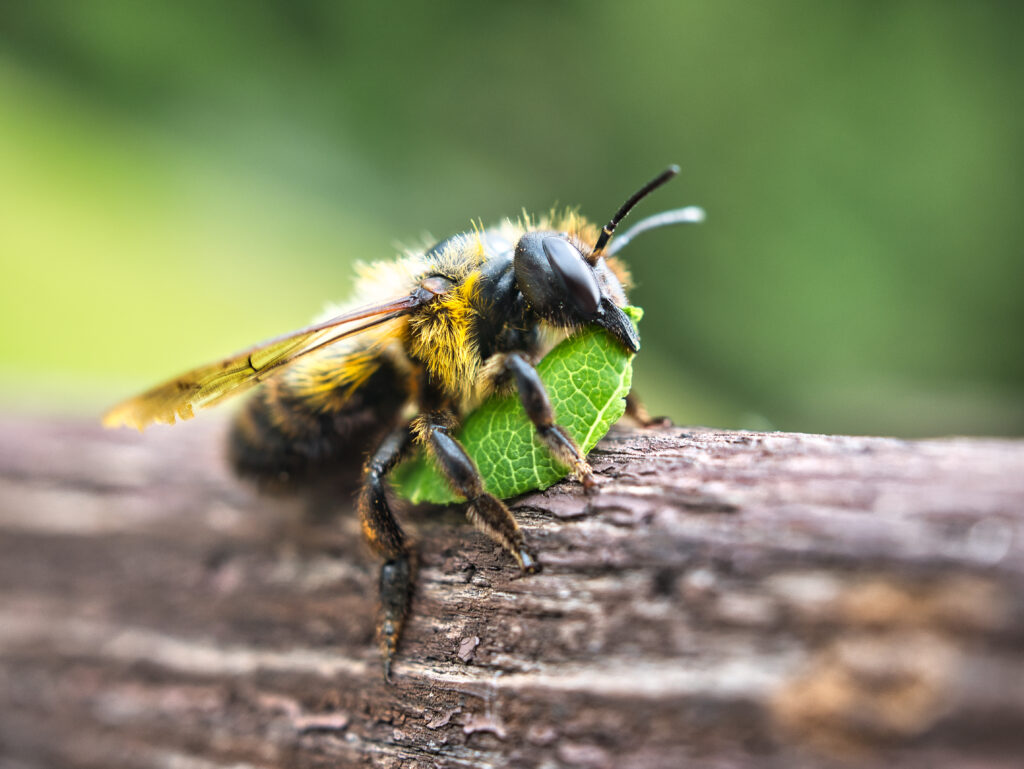
Female leafcutter bees possess a stinger and won’t hesitate to use it if handled roughly.
©Maurice Lesca/Shutterstock.com
Leaf cutter bees are quite the architects, crafting their nests with bits of leaves. These creatures are vital to many plants, especially alfalfa. Each female bee constructs her own cozy dwelling in a cramped cavity, like a hollow plant stem, a wood crevice, or a paper straw. They’re also not prone to swarming, as they’re solitary insects that don’t form colonies or share nests. However, they may aggregate in areas where suitable nesting sites are abundant.
Leaf cutter bees are primarily black with white bands on their abdomen. They’re about the same size as honey bees, but females have a pointed abdomen, and males have a blunt one. Males also have very hairy faces and no stingers. Female leafcutter bees possess a stinger and won’t hesitate to use it if handled roughly. Their sting feels more like a mosquito bite than a honeybee sting.
They’re active from spring to fall and visit various flowers for pollen and nectar. Some species prefer certain types of leaves for their nests, such as roses, lilacs, or clovers. Some species don’t cut leaves at all but use resin instead. One of these species is the giant resin bee (Megachile sculpturalis).
14. Miner Bees (Andrena)
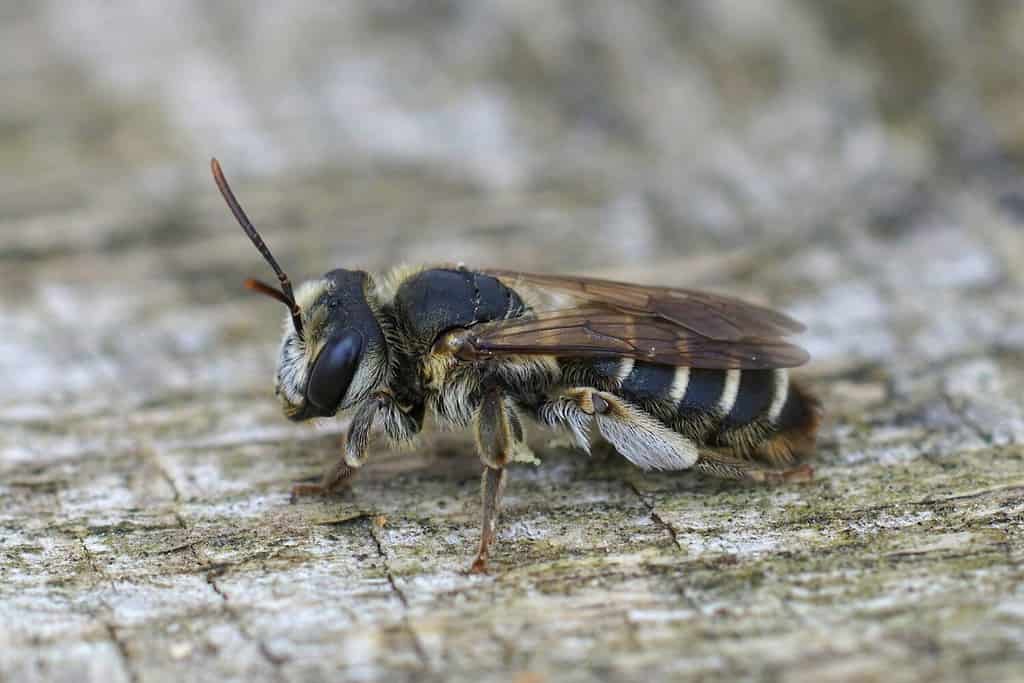
They construct their nests in sandy or loose soils without forming colonies or social groups.
©HWall/Shutterstock.com
Miner bees are ground-nesting bees belonging to Andrenidae. They have black or brown bodies with white hair bands on their bellies. Occasionally, they may appear reddish or shiny blue/green. The bees transport pollen on their hind legs, while a few have a propodeal corbicula on their thorax.
Miner bees construct their nests in sandy or loose soils without forming colonies or social groups. Although they may reside near one another or use a common entrance, they don’t swarm. Every female bee gathers pollen and nectar from specific flowers and forms them into balls, which she deposits into her nest cells, often coordinating with the flowers’ blooming period.
15. Carder bees (Anthidium)

They’re called carder bees because they collect plant hairs or fibers to line their nests.
©Wirestock Creators/Shutterstock.com
Carder bees are a genus of solitary bees belonging to the family Megachilidae. Their body is mainly black but has yellow spots on their sides and abdomen tip. The legs and abdomens also have yellow markings. Males are significantly bigger than females. Carder bees don’t swarm.
They’re called carder bees because they collect plant hairs or fibers to line their nests, which they usually build in cavities such as holes in wood or walls. Carder bees have pollen-carrying structures on the underside of their abdomen, unlike most other bees that have them on their hind legs. They’re cosmopolitan in distribution and have many species, some of which are invasive in certain regions.
Florida’s Diverse Bee Species: Final Thoughts
Florida’s buzzing ecosystem is home to many bee species, each with its own distinct behaviors and habitats. The honey bee, bumble bee, carpenter bee, sweat bee, and leafcutter bee are among the most diverse and widespread. These bees boast unique adaptations and intricate relationships with the surrounding flora and fauna. From pollination techniques to social structures, each bee species brings a dynamic and intriguing element to Florida’s natural world.
The photo featured at the top of this post is © Brier Mitchell/Shutterstock.com
Thank you for reading! Have some feedback for us? Contact the AZ Animals editorial team.






